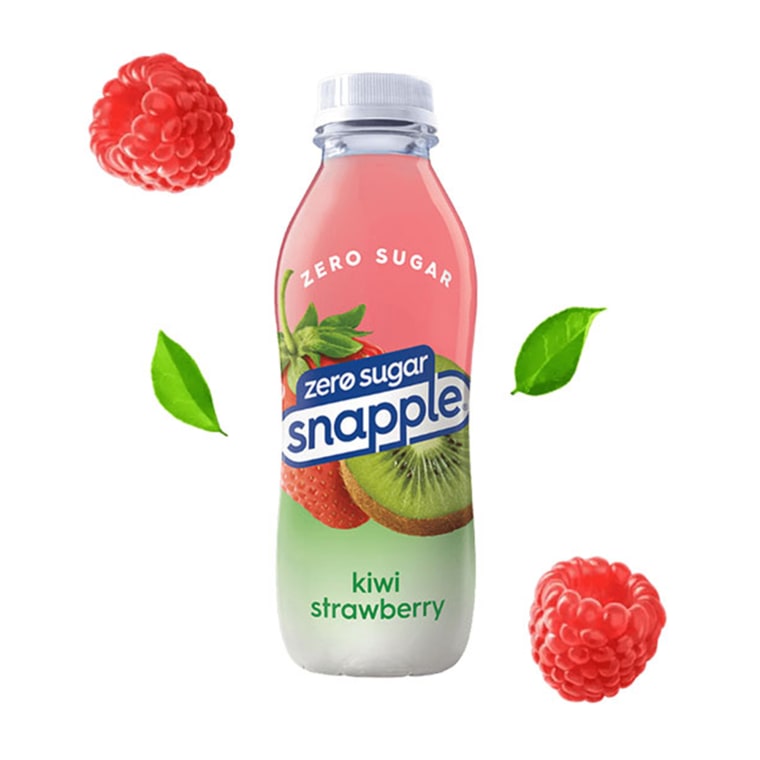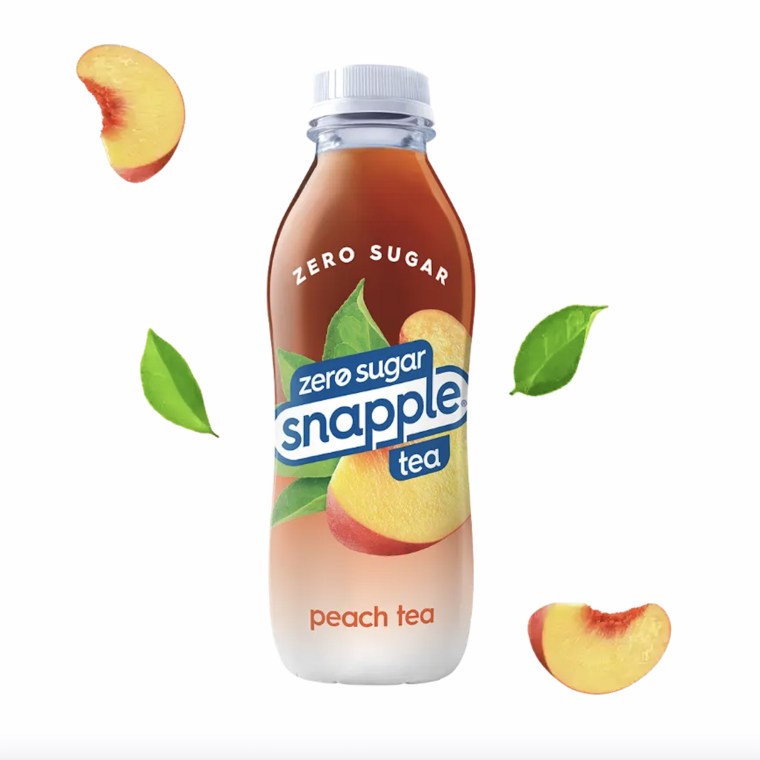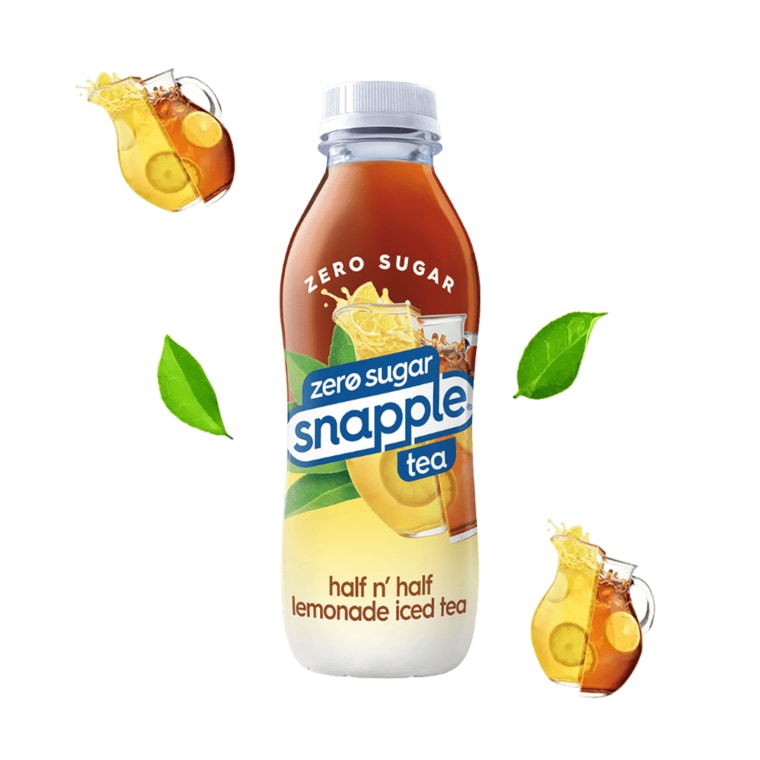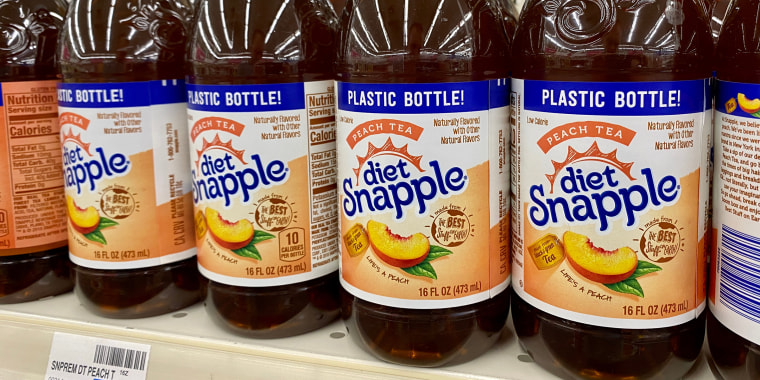Pour one out for Diet Snapple. It has expired, gone to meet its maker and joined the choir invisible, as first reported by Food and Wine. Bereft of life, it rests in liquid peace. Before all you devotees go sobbing woefully into your last bottle of Diet Takes 2 to Mango, though, take a look at the label of new Zero Sugar Snapple. See anything interesting? Why yes, you do! You see that there is zero change to the ingredients list. It’s a miracle!
Although the branding on the bottle doesn’t specify the lack of change, Snapple is not really trying to hide it, either. On the Zero Sugar page of its website showing the seven available flavors, it says it right at the top: "Zero sugar is the new diet." In addition to the familiar tea-based varieties, there’s also a new low-calorie version of the iconic Kiwi Strawberry Snapple. It’s available nationwide in single-serve bottles that retail for about $2, as well as multipacks of up to 24 bottles. If you read reviews, you’ll see that some people complain it tastes different, but that appears to be the power of suggestion. Snapple insists that they’re the same flavors — they just have fancy new duds.

Why rebrand if you haven’t reformulated? Diet Snapple is just the latest casualty in the no-calorie beverage terminology wars. "Diet" is a four-letter word these days, ensuring lagging sales because of its historical marketing baggage. Decades of misapplication of the term to products that were nonfat but high in carbs has nailed that coffin shut pretty firmly. Even when it really is low in calories, calling your product "diet" associates it with deprivation, bitter aftertaste, and even worse, it’s unfashionable. It might as well be wearing skinny jeans with a side part. Conversely, "zero sugar" is meant to seem unambiguous, clean, modern, and maybe to signal to the drinker that newer formulations approximate the flavor of real sugar more closely than the old, even if there hasn’t been a change.

"Snapple Zero Sugar is the same great taste and formula that consumers love. We’ve updated the name and packaging to more clearly articulate the zero sugar benefit," a spokesperson for Keurig Dr Pepper, Snapple's parent company, told TODAY Food in an email. "Over the past few years, we have seen a major shift from diet culture in beverages, and the tea consumer is no different. The decision to reposition Diet Snapple to Snapple Zero Sugar was a choice made to deliver on our consumers’ needs."
What's the deal with no-calorie sweeteners?
If you’ve read a few of my other columns, you already know I’m not a fan of no-calorie sweeteners from a health standpoint. There’s an excellent write-up compiled by a colleague earlier this year that details the possible metabolic effects, upset stomachs, gut bacteria changes, and chronic disease risks that appear to go along with frequent consumption, but just in the short time since that one hit the web, another study has come out also linking artificial sweetener intake to cancer risk in people who consume them often.
There’s a lot of confusion about what the term "artificial sweetener" means, too. Often patients tell me they assume that it means they’re chemically manufactured rather than derived from a natural source, but actually it just means that it’s not sugar, honey or another refined carbohydrate like fructose. They are sweetening substitutes that are zero-calorie or low-calorie, but they are often refined from plants. The study linking artificial sweeteners to cancer mentioned above, for example, included steviol glycosides from the stevia plant.
There is still a lot to this picture that is unclear, and it may yet turn out that one or another sugar substitute is healthy, or at least not harmful. At present, though, I rarely recommend them for routine use. They just don’t appear to be correlated with maintaining a healthy weight; on the contrary, studies have repeatedly shown that they may be associated with weight gain and the development of Type 2 diabetes.
As a dietitian, I experience more heartbreak from hearing the experiences of patients with eating disorders than any other condition. I’m fully on board with eliminating the word "diet" from popular culture and dedicated to a model of healthy eating that is based on a truly diverse range of foods, without a restrictive, deprivation mindset. Study after study shows the latter doesn’t work for long. But, is it really progress if they’re selling you the same product with a different name? No matter what they call it, it sounds like the same old pipe dream to me, that you can be skinny, happy, witty, fashionable and debt-free by eating all the junk you want. Rebranding just lets them keep your skin in the game, literally.

So, what should you drink instead?
I usually suggest getting used to less sweet taste overall by switching to unsweetened beverages, but for many of us, that’s a process. You may need to start out with just less sweetened, either by mixing things like sweet and unsweet iced tea, adding fruit juice to sparkling water, or reducing the amount of artificially sweetened flavoring you add to your water bottle. A water infuser lets you customize the ingredients you like best, and if you add sliced citrus, crushed berries or herbs and leave it in the fridge overnight, you might be surprised at the depth of flavor.
Commercial bottlers are starting to get the message that less sweetening is desirable, too, and there is a growing retinue of totally unsweetened and lightly sweetened beverages on the market. Although it still has about 100 calories and over 20 grams of sugar, Snapple’s Elements line (recently resurrected from the '90s) has half the sugar of its regular juices and sweet teas, and its regular Green Tea flavor is about the same. Sanpellegrino Momenti is flavored with a little bit of real fruit juices and runs about 35 calories and just 7 grams of sugar. Laird’s Hydrate is an economical powdered coconut water electrolyte replacement with 40 calories and 10 grams of sugar, and most other ready-to-drink coconut waters are 60 calories and 15 grams of sugar or less, about right for a moderate workout. If you cut back on sweetness gradually, you may be able to genuinely enjoy totally unsweetened choices like Coca-Cola’s inventive flavor-paired AHA waters (available caffeinated!), Pure Leaf’s Unsweetened Black Tea, Topo Chico Mineral Water (try the Twist of Grapefruit!) and home-brewed hibiscus, mint or rooibos iced teas.
This may be hard for some of you to believe, but after years as a Kool-Aid and sweet tea enthusiast, over time I’ve even come to truly revere the shining, reflective and rare gem that is … plain water.
